Is Gumroad the right place to build and sell your courses? Find out with Whop’s guide.
Key takeaways
- Gumroad lacks a dedicated course-builder tool, requiring creators to manually upload files and create pages.
- Gumroad's fees can reach 40% when using the Discover feature for visibility (10% base plus 30% for promotion).
- Gumroad works best for simple digital products but offers limited functionality for structured course creation.
E-learning is booming, making it an attractive space for anyone looking to make money online. It’s ripe with opportunity – you can create a course in any niche, and enhance your offering with ebooks, podcasts, and more.
However, to succeed, you first need a solid platform to host your courses. These platforms simplify the process, helping you build, publish, and sell your content quickly and easily.
But with so many options out there, which platform is the best for your course?
In this guide, we’ll take a look at one of the biggest players available today – Gumroad. We’ll also explore some alternatives.
Ready to get started?
Why Sell Courses Online?
E-learning really took off during the pandemic, and it continues to grow. Online learning has many benefits – for both students and course creators.
Students like the convenience of accessing their course content on the go, while teachers and creators can work with a larger base of learners across the world.
The demand for online learning speaks for itself, with the e-learning market expected to grow to nearly $843bn by 2030.
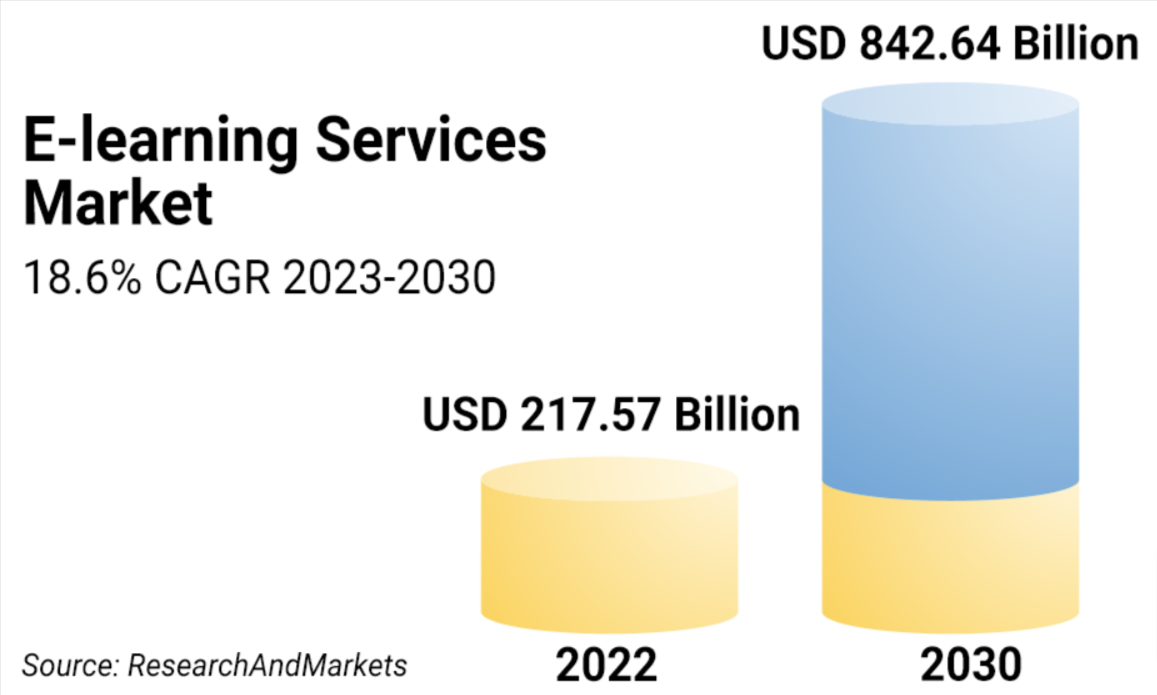
In addition, e-learning is a flexible and scalable business, which lets you build authority in your area of expertise.
This means that online courses are also only the beginning. You can harness your knowledge and leverage your audience to develop and sell such complementary products as:
You can create courses in any niche, from sharing hobbies to helping people make money online. People are willing to spend money to gain skills, further their careers, or improve their lives.
So, if you want to launch an online business or explore a new opportunity, you might find a lucrative home in the e-learning space.
One of the most important things to consider is where your course will live online. Content creation platforms are a good option. They support publishing and monetizing your content, in addition to processing payments and offering a dashboard to keep track of your earnings.
One of these content monetization platforms is Gumroad – but how easy is it to use and is it a good home for your course?
What is Gumroad?
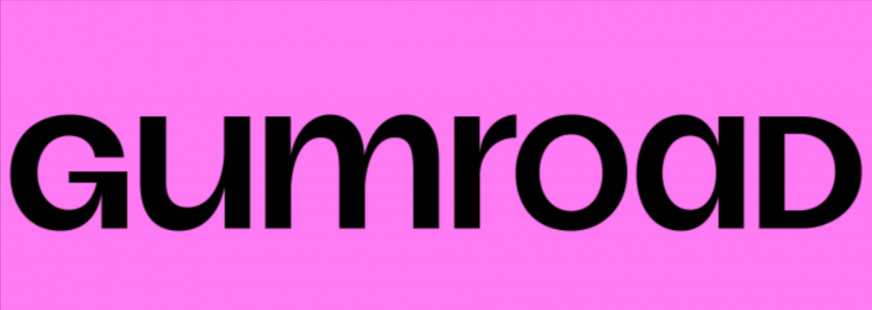
Gumroad is a platform that supports creators in monetizing a range of content, including ebooks, video & audio, memberships – and courses.
At first glance, the site has a laid-back, colorful vibe and a simple dashboard. Go a bit deeper and you find that the functionality and customization options are limited, especially for course creation.
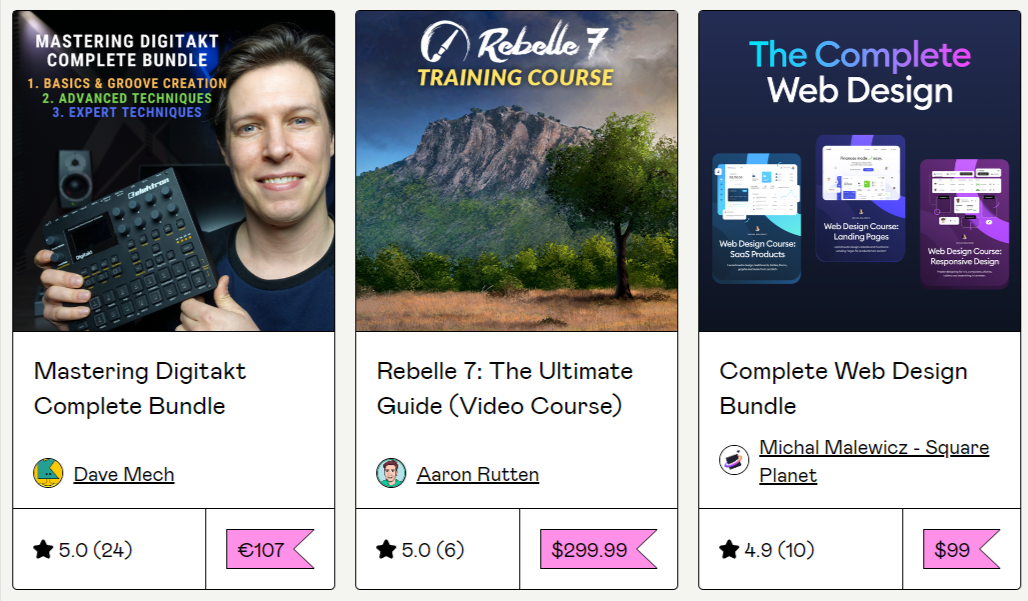
However, with no monthly fee and an easy-to-use interface, it’s worth getting up to speed with how Gumroad works for course creators.
How to Sell Courses on Gumroad: A Step-by-Step Guide
Here are the basic steps you need to take if you want to create and monetize courses on Gumroad.
1. Open a creator account

If you haven’t already opened a creator account on Gumroad, head to the homepage and click on “Start selling” in the top left of the screen.
This takes you through to the sign-up page. Choose to link to one of your existing accounts – Facebook, Google, Twitter (X) or Stripe. You can create your account with an email address and password if you prefer.
Once you’ve completed the two-factor authentication process, you’ll be able to access the Gumroad dashboard.
Go to the “Profile” section to choose a username and add a bio and logo.
2. Create your course
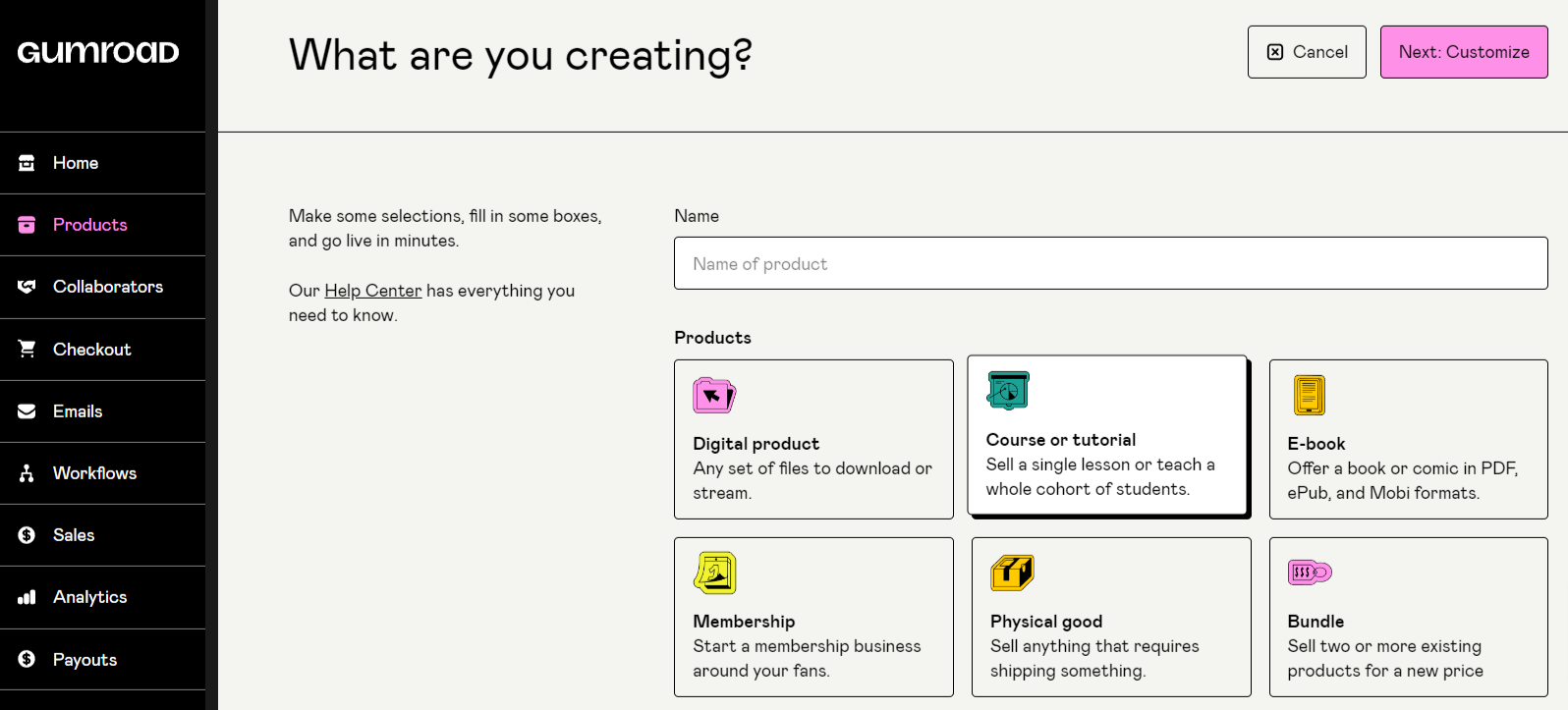
On your dashboard, click on “Products” in the left-hand menu. You will be given the choice of which type of product to create. Choose “Course or tutorial”.
At this stage, you just need to name your course (you can change this later). Scroll down to choose a currency and set a price.
Click on “Next: Customize” to fill out the details of your course and to add the content.
3. Add the details of your course
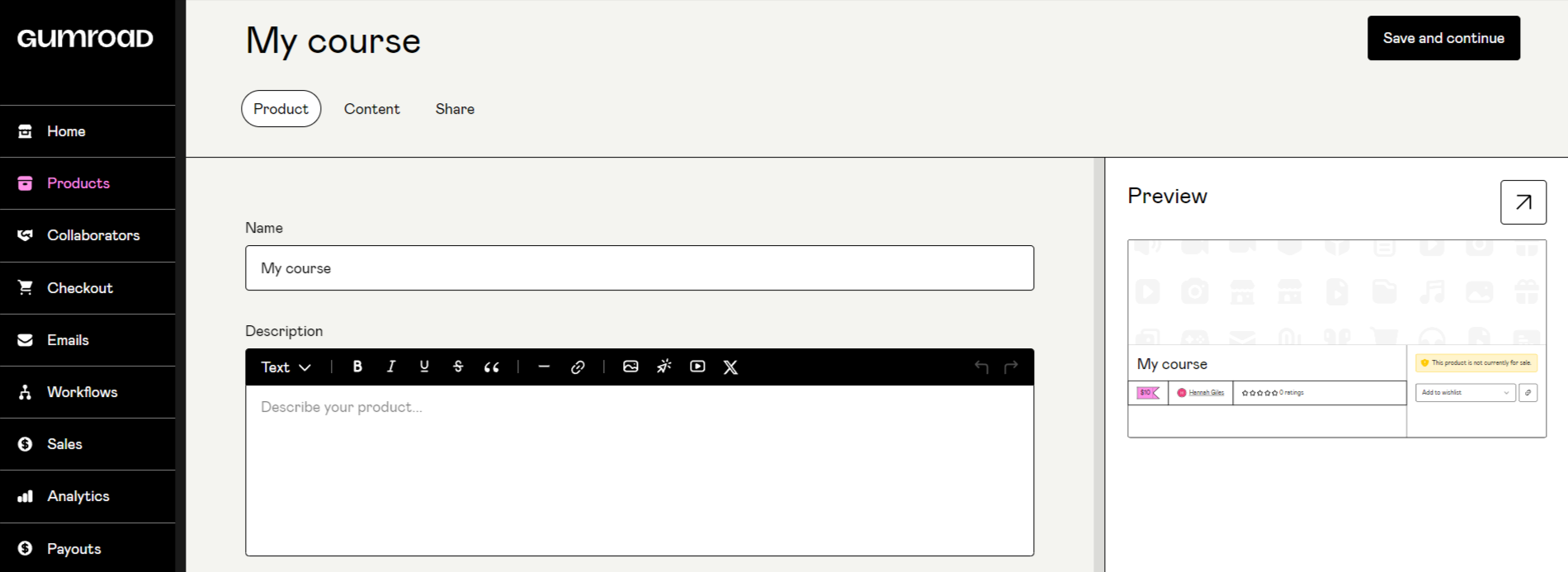
You’ll see three sub-sections at the top of the screen: “Product”, “Content”, and “Share”.
On the “Product” page, you can rename your course, if you wish, and also add a description.
This will appear on the sales page, so make sure you include enough detail to attract users without bogging the description down with too much text. Take a look at some examples on the site to get an idea of what works and what doesn’t.
In this section, you also add:
- Your URL extension: This is the unique link to your course. It will start with “your username.gumroad.com”.
- Custom domain: This is an optional field, which lets you set a custom domain for an individual product.
- Cover: Here, you can upload an image to serve as the cover page for your course.
- Thumbnail: You can also add a smaller thumbnail image for display in the Gumroad Library (where users find your course).
This section also lets you add some basic product info, including a CTA (call to action) and additional product attributes.
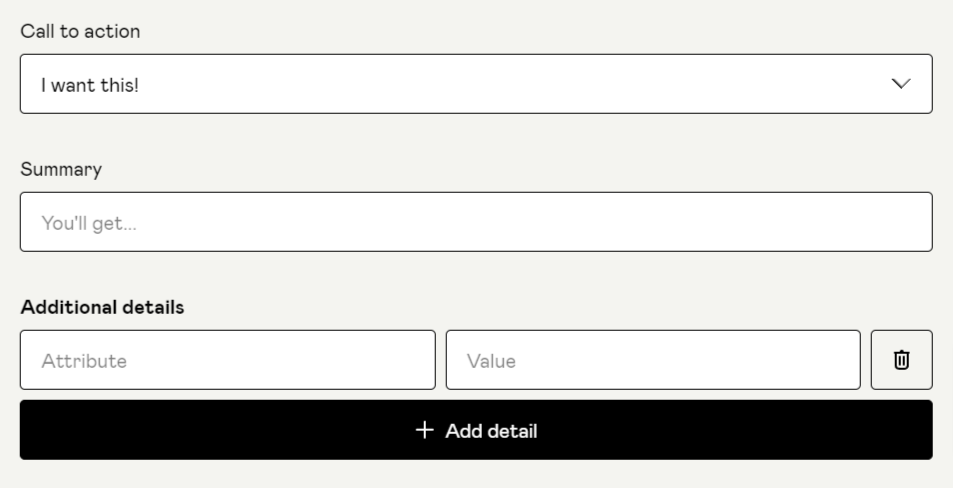
Further down, you can add integrations to invite customers to a Circle and/or Discord community. In this section, you can also change the price of your course (including a “pay what you want” option).
Additionally, you can add alternate versions or formats of the course, such as a second language option. There are a few more customizations at the bottom of the page.
As you make your adjustments, you’ll see a running preview of your course on the right-hand side of the screen.
You can then move to the “Content” section.
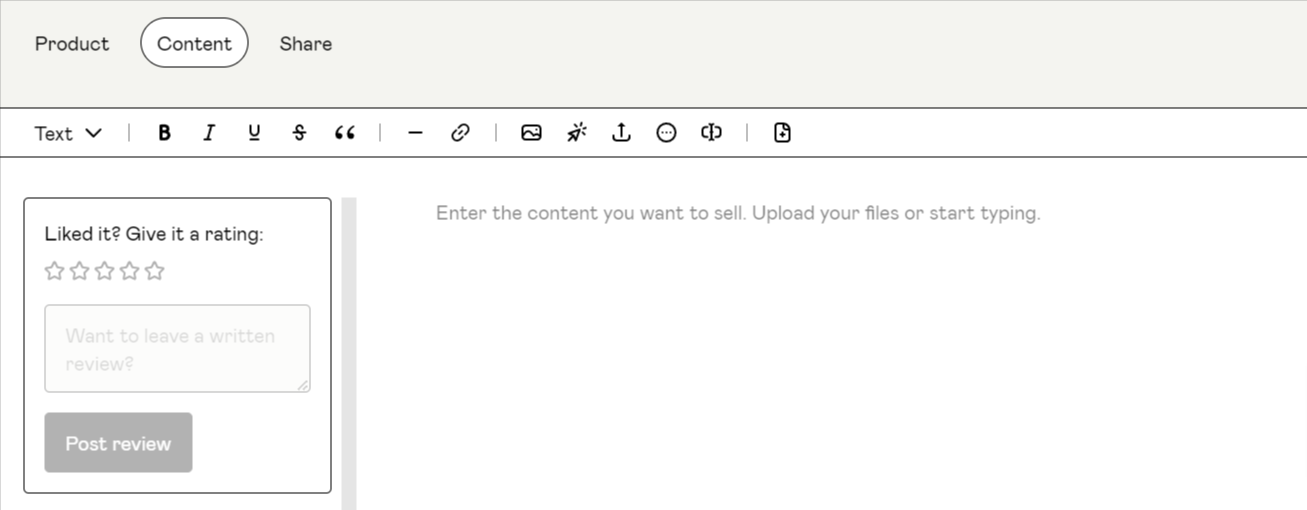
Here, you can add your course content. This is one of the areas in which Gumroad falls short for course creators.
Unlike some platforms, there is no course-builder tool. You simply type in your content, upload files (such as PDFs), insert images or links, and create multiple pages.
Once you’ve added the content, the next stage is to click “Publish and continue”.
This takes you to the “Share” section, where you can see a preview of your published content. There are also buttons to share your course on Facebook and Twitter (X).
This is also the place where you can boost your course through Gumroad Discover – more on this below.
Here you can see a preview of your course. There’s even an “Unpublish” button if you want to take it offline to make changes.
4. Customize your checkout
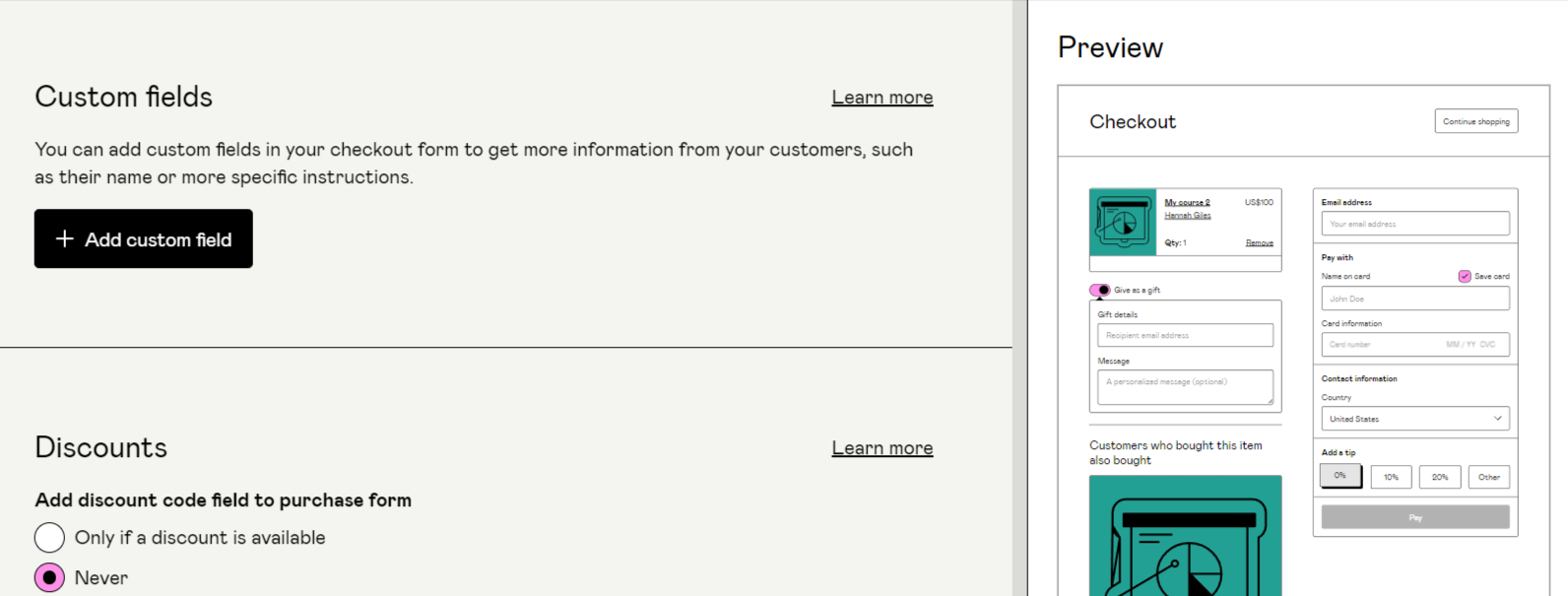
Click “Checkout” on the dashboard menu to tailor this page for your customers. The customization options include the text fields displayed, discounts, and recommendations.
You can view a preview of your checkout page on the right-hand side of the screen to see the impact of any changes.
5. Set up your workflows
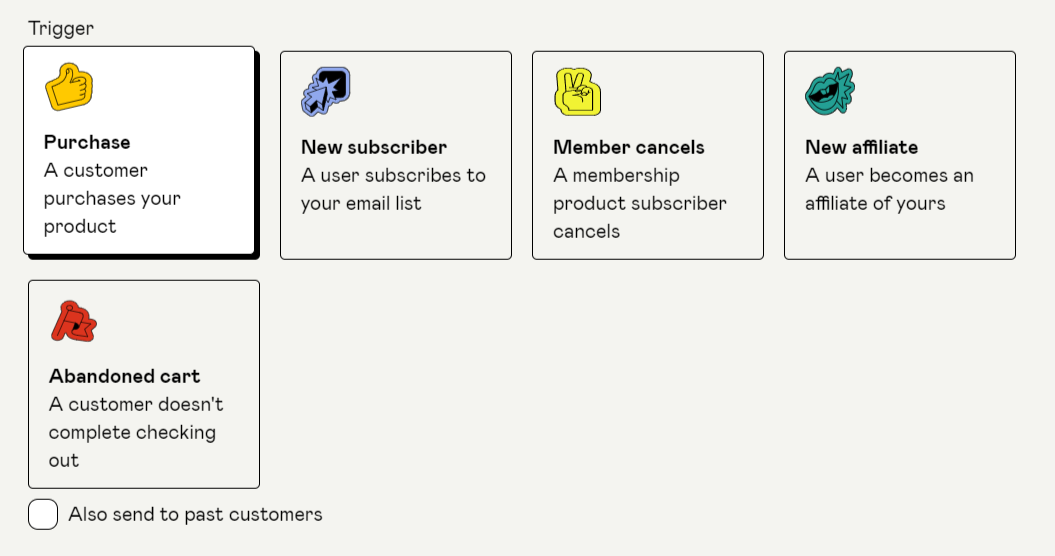
The email marketing options with Gumroad are limited, but you can set up some automated responses.
In the “Workflows” section of the dashboard, you can enhance customer engagement with emails that are triggered following a defined action.
For example, if someone abandons their shopping cart before completing the transaction, they’ll get a reminder. You can also set up “thank you” emails when a new customer buys your course.
Head to the “Email” section of the dashboard to send out a one-off email to your audience.
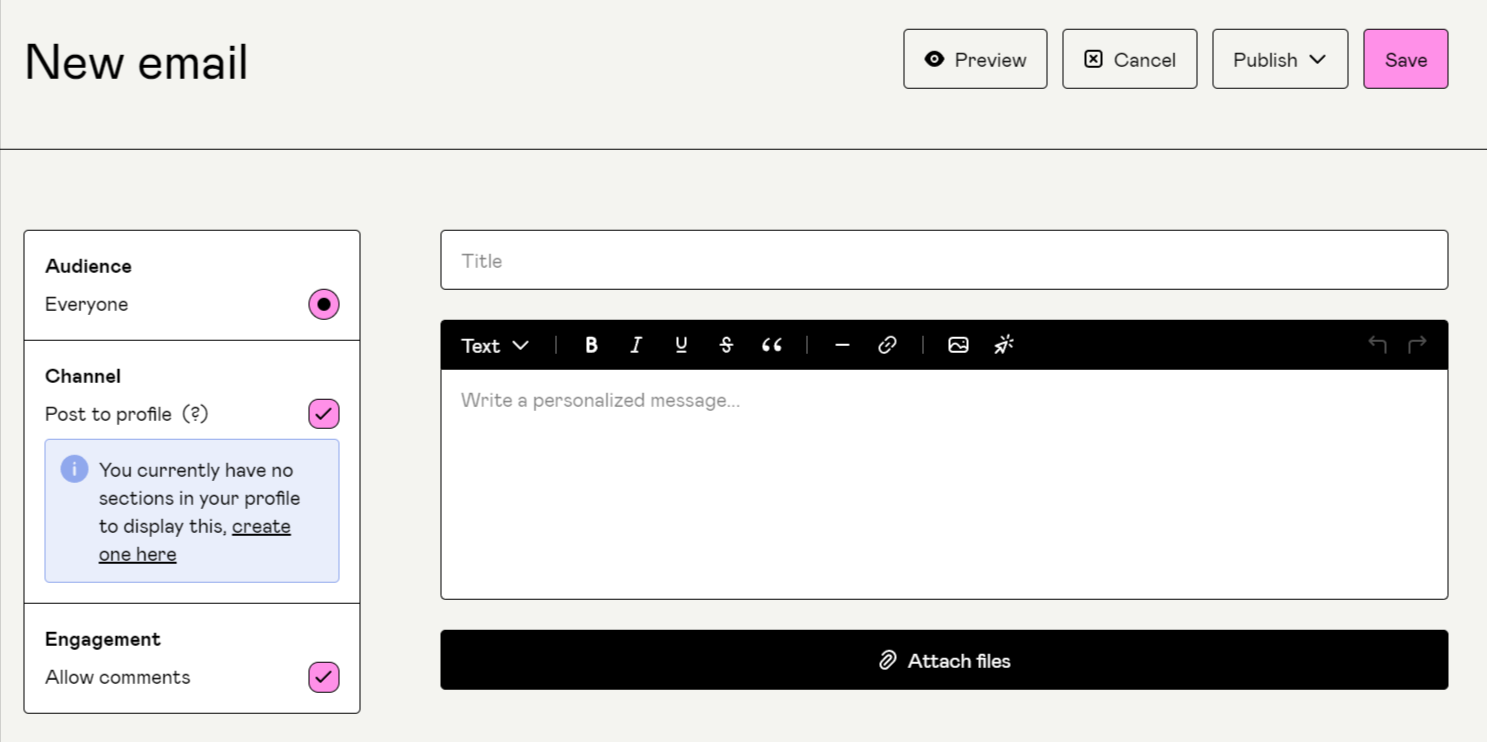
Using these features together also lets you send out a “dripped email course”. This is where customers are automatically sent lessons periodically in a specific order to build a full course.
6. Enable payouts
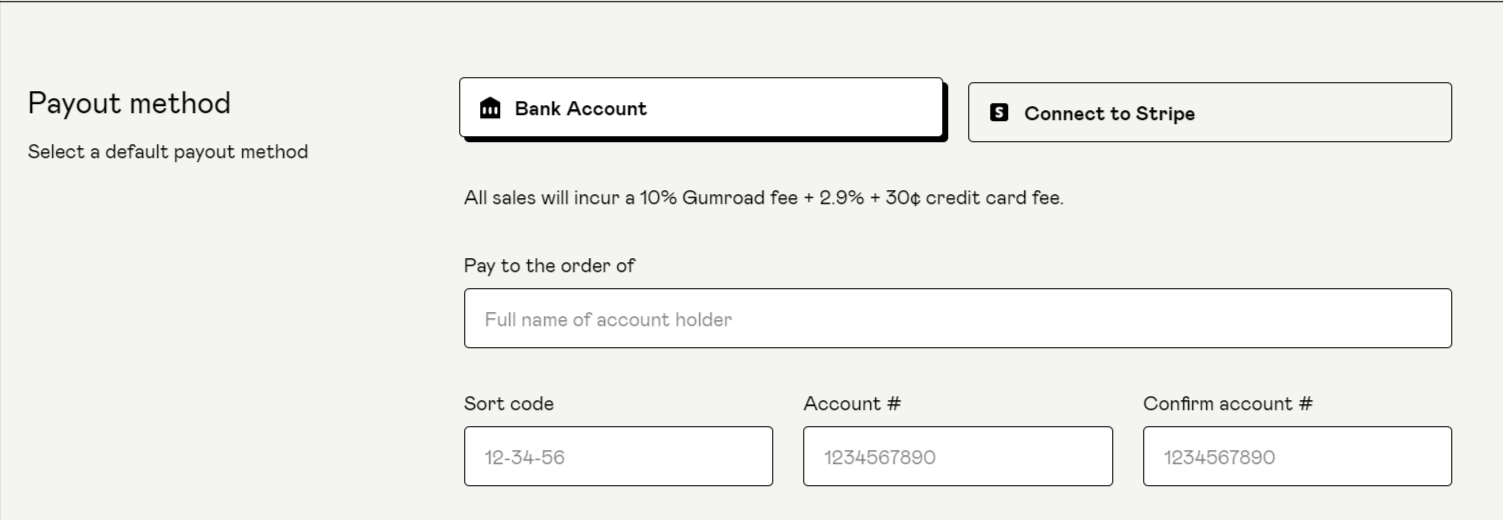
One important task before you can start selling courses on Gumroad is to set up your payments. To get paid from Gumroad, you need to add your bank account details or connect with Stripe.
Head to “Settings” and click on “Payments” to add your details. This ensures you receive payouts (less the 10% fee and processing charges). Once you hit $10 in sales, Gumroad will start paying out.
The payment methods Gumroad accepts from customers are credit cards and PayPal. If you want to offer your customers PayPal as an option, you first have to connect your bank account or Stripe account.
7. Track your progress

Once you’re up and running with your course and you start landing sales, Gumroad offers a basic set of analytical data to help you track your progress. The available data covers:
- Sales
- Views
- Revenue
- Referrals (if applicable)
- Locations (of your customers)
There is also the ability to integrate Facebook Pixel and Google Analytics.
Now you know the basics of setting up a course on Gumroad, let’s take a look at how a course is displayed to potential customers.
An Example of a Gumroad Course
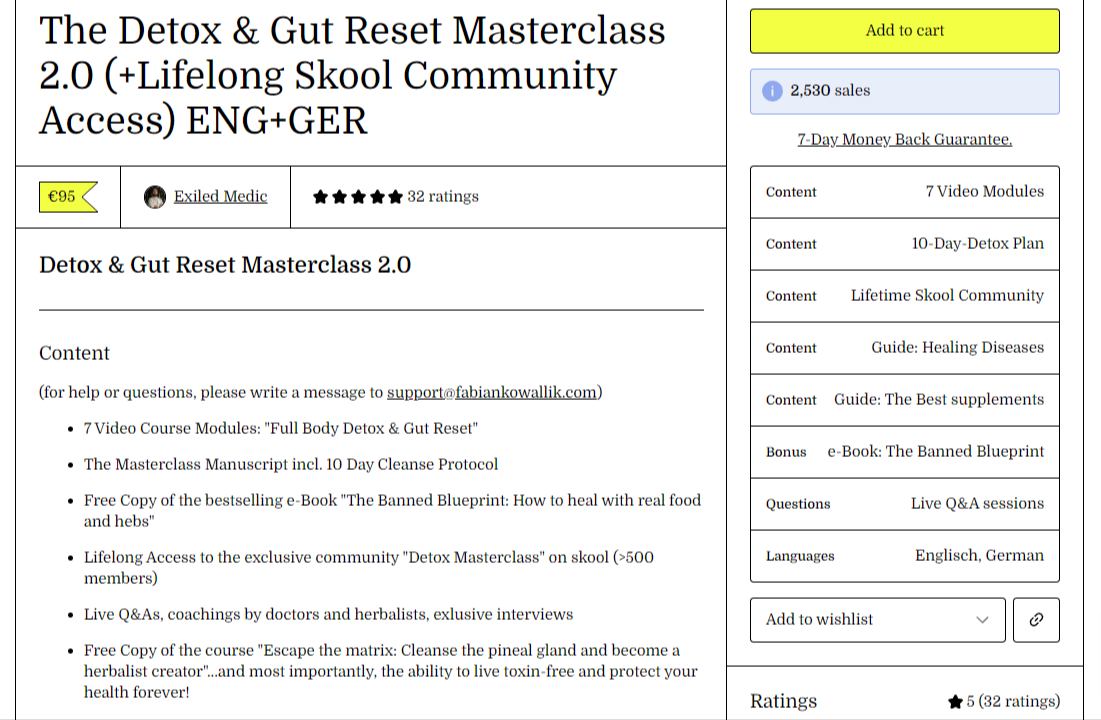
This 'Detox and Gut Reset Masterclass' course offers people a seven-video series of lessons on detoxing. It’s also a good example of the type of content you can create to support your course.
The supporting content includes an ebook and access to a community (hosted on a separate platform). Users can also benefit from live Q&A-style coaching sessions and a free supplementary course.
When people add this course to their shopping cart, they are taken through to the checkout page. The options are to pay via credit card or PayPal. Users pay a one-time fee for lifetime access to all the content.
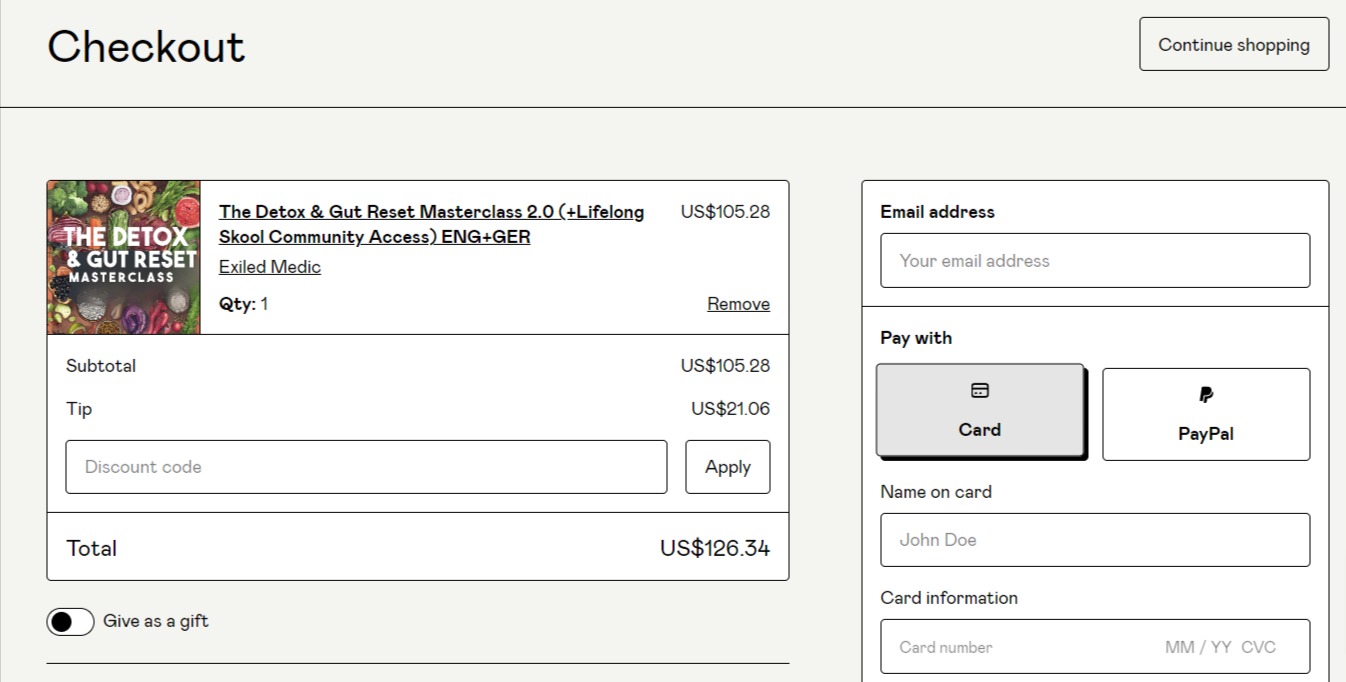
You’ll notice that there is a $21.06 charge added to the total as a “Tip”. This is an option under the “Checkout” tab on your creator dashboard. It’s simply an extra show of support by customers who are fans of your content – like your own personal (virtual) tip jar.

If you enable this option, you can set a field in your checkout page to offer customers the ability to add a tip of 0%, 10%, or 20% or to choose their amount.
Monetizing Your Course on Gumroad
Once you’ve set up and published your course, Gumroad offers a few ways to promote the content to users so you can start seeing a return on your efforts. Let's take a look at them.
Gumroad Discover
One way to give your course a boost on Gumroad is to take advantage of the optional Discover feature.
If you choose to enable (and pay for) this feature, your course will enjoy a more prominent placement on the site.
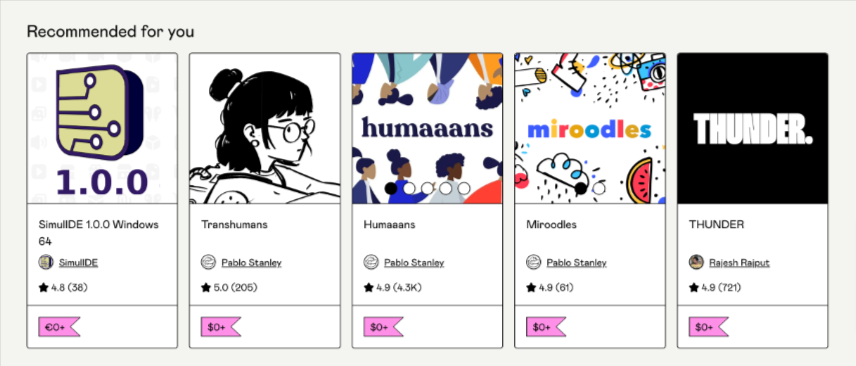
When customers are logged in or click into any of the product categories, they’ll see a section at the top of “recommended” products. This enhances visibility and encourages people to take a closer look at your content.
To use this feature, you need to set up your payment options through your dashboard. You also need to have earned at least $10 in genuine sales, and your course price must be less than $100.
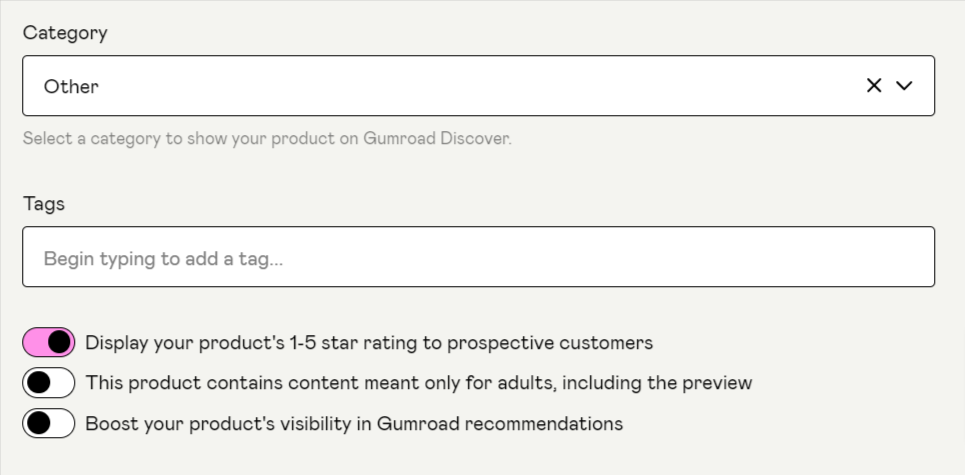
Gumroad lets users choose how much they pay for this boost. It is charged as an extra per-sale fee, at a minimum of 30% - that's on top of the 10%. So, that brings Gumroad's 'Discover' fee to 40% - not an insignificant amount.
The more you pay, the more prominently Gumroad will display your product.
This may be a good option to get your product off the ground. However, that percentage will really take a bite out of your revenue.
Integrations
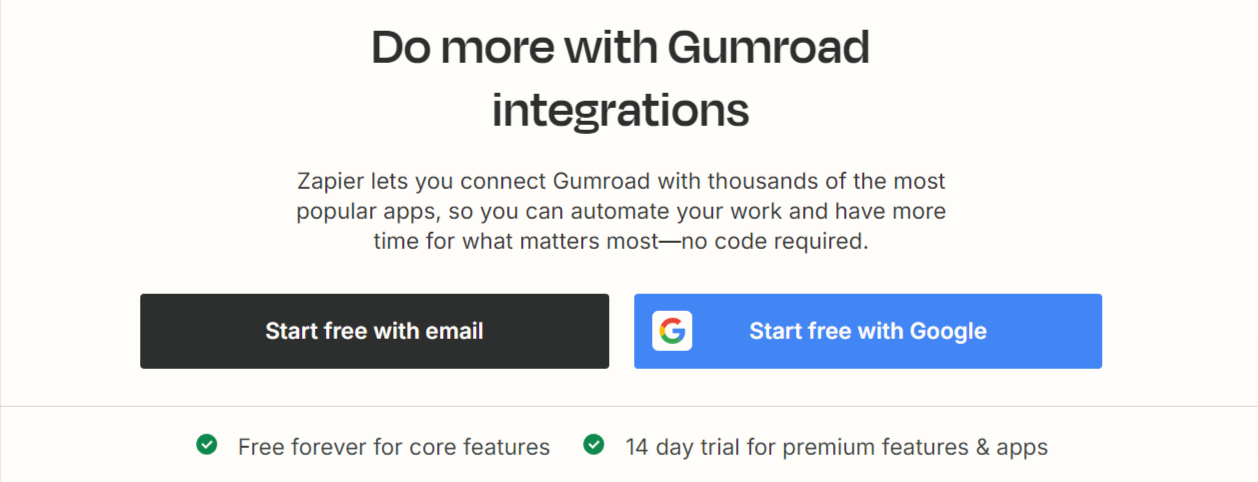
As we’ve highlighted, Gumroad is pretty limited in terms of its functionality and email marketing. You can add more features to your store with integrations.
Gumroad allows you to integrate Zapier, which unlocks a range of third-party apps, including MailChimp, Discord, and AWeber.
These apps can help you to increase engagement and boost sales of your course. However, extra costs and fees will apply, depending on which apps you want to add to your Gumroad creator account.
Affiliates
Gumroad offers a limited affiliate program. This lets people market your course on your behalf and claim a 10% commission for sign-ups.
Affiliate marketing can be an effective tool, as long as affiliates have a large enough reach and send you quality leads – i.e. people who are likely to buy your course or subscribe to your email list.
The big drawback of the Gumroad affiliate program is that you have to add affiliates manually, with no ability to create an affiliate sign-up page. All Discover products are available for affiliates to promote.
Now you know more about selling and monetizing courses on Gumroad, is the platform right for your needs?
Should You Sell Courses on Gumroad?
On the plus side, Gumroad is a straightforward platform that can support basic course creation and monetization. You can also expand into selling other types of digital content (and physical products).
In terms of popularity, Gumroad has grown considerably in recent years regarding the number of active stores or sellers on its site. According to Store Leads, there are now nearly 17k active creators on the platform, while Gumroad itself boasts its users have generated over $1bn+ in sales.
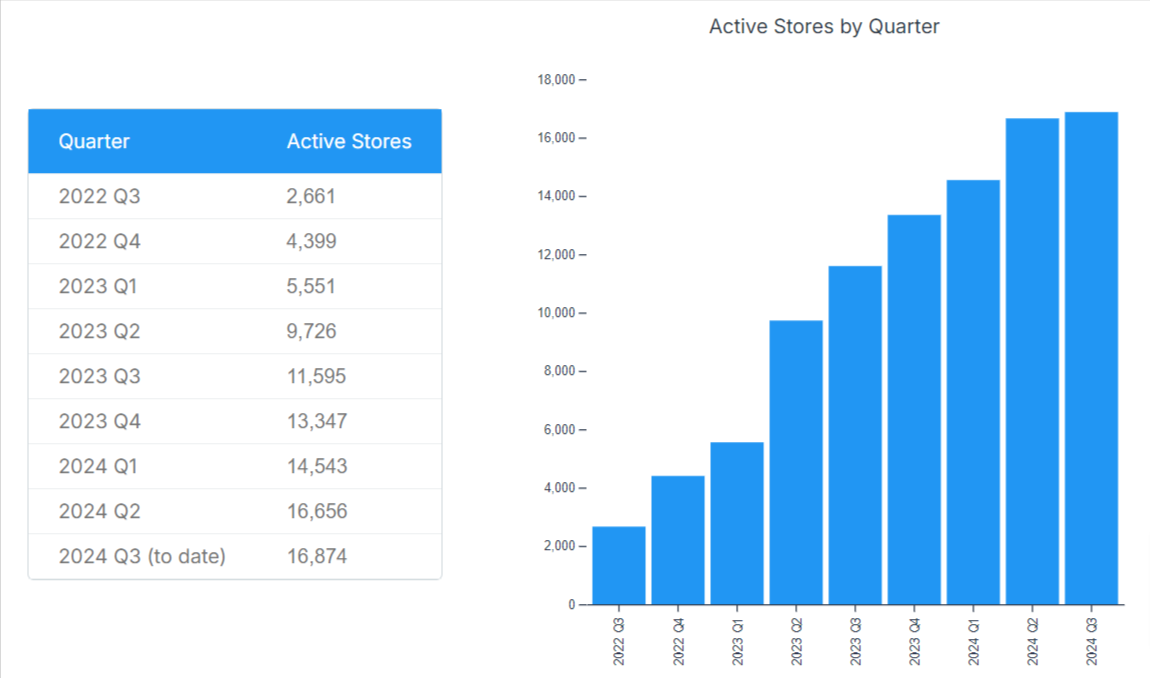
However, the platform does have its limitations, especially for course creation.
It has basic functionality and there’s no escaping the fact that the platform is skewed towards selling digital downloads, not online courses.
For example, there is no dedicated course builder, which makes creating course content simultaneously a simple and laborious process of attaching or uploading your content. Your only other option is to send out a dripped email-based course through the “Workflow” menu on the dashboard.
Then, while Gumroad does allow you to create memberships and offer tutorials, an overall lack of functionality in this area means it is not great for managing your course content and engaging with your learner base over the long term.
It is also not the best platform to support affiliates, if you plan on going down this route to help sell your courses. Plus, the analytics are quite limited, and added functionality requires integrations such as Zapier, which can incur extra costs.
It’s also worth noting that user reviews of Gumroad are not great. A small number of users who have left feedback on Trustpilot flagged issues like poor customer support and accounts being suspended without notice.

As you can see, while on the surface Gumroad offers a lot of functions, it does not do this well - the functionality is basic and you have to rely on multiple integrations, increasing your costs and complicating your business.
Finally, Gumroad is not the most competitive platform out there when it comes to fees.
Gumroad charges a 10% transaction fee on every sale. This might not sound much, but it means that for every $500 you make, Gumroad takes $50. Make $5,000 and you lose $500. You can see how that will add up over time.

In addition, you will pay the applicable standard payment processing fees. The credit card processing fee is 2.9% + $0.30 per sale. In addition, PayPal fees might apply.
You also need to factor in the high cost of Gumroad Discover if you want to take advantage of this feature to get your course prominently displayed to potential customers. Let's say your $500 course is promoted through Gumroad Discover - you only get to keep $300 of that, minus processing fees.
Selling courses on Gumroad: The verdict
Overall, if you want to focus exclusively on selling courses online, some platforms are more suited to this type of content.
These platforms offer dedicated course builders to save you time and give your course a professional and streamlined look and feel.
One important thing to remember is that user engagement is key in e-learning. So, you need to choose a platform that allows you to connect with learners and potentially upsell additional content.
Similarly, if you want the freedom to move beyond courses and sell anything online, there might be a more comprehensive option. All-in-one platforms will grow with you and support your journey to success as an online entrepreneur.
Speaking of which…
Alternatives to Gumroad for Selling Courses
Here are just a few alternatives to Gumroad for building and selling courses.
1. 🏆 Whop
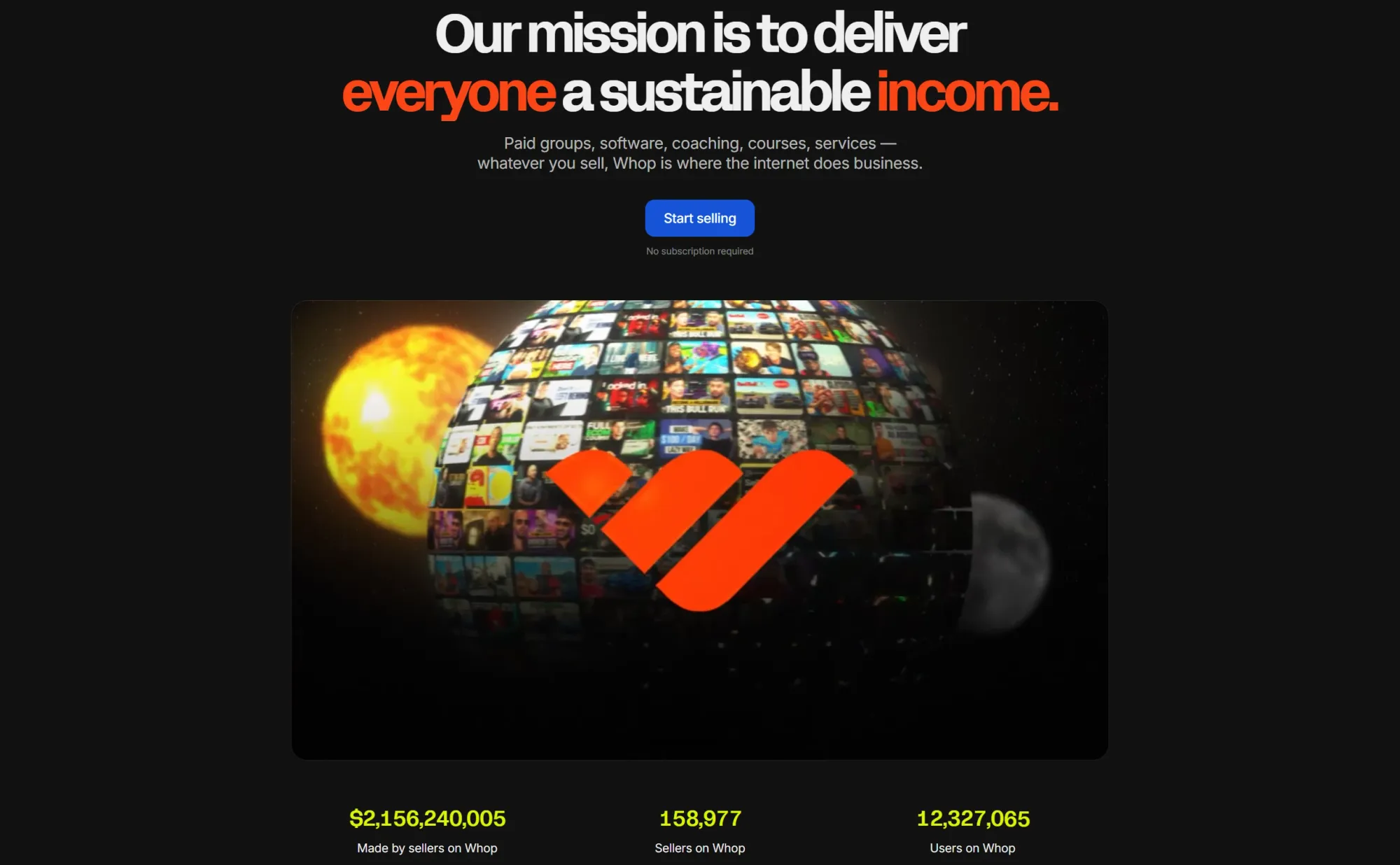
Whop is the best Gumroad alternative, offering the ability to grow and scale any kind of online business, offering huge flexibility. With Whop you can create and sell online courses, private community, digital downloads such as worksheets and ebooks, and host video calls - all from your own whop. You can also manage your affiliates, memberships, and payments within your Whop dashboard.
The 2.7% + $0.30 fee on sales easily beats Gumroad, and the user-friendly interface means anyone can create their ideal e-learning business and turn their expertise and ideas into $$$.
2. Podia

Podia is a well-known platform dedicated to online courses and digital products. There are various plans available, with a free option. However, this incurs a 10% per-sale transaction fee and is quite limited in terms of features and functionality.
Upgrade to one of the paid plans and you’ll pay $33 a month (plus 5% transaction fees) or $75 a month (0% transaction fees).
3. Teachable

As the name suggests, this site is all about supporting creators who want to teach. On the Teachable platform, you can offer online courses, digital downloads, and coaching.
Again, there’s a free plan with 10% (+$1) transaction fees, with paid plans costing $39, $119, and $199 a month when paid annually.
4. Thinkific

Another option is Thinkific, where you can sell courses and build communities. It offers a simple interface and a good selection of tools.
There’s a free limited plan for test-driving your course, with paid plans at $36, $74, and $149 a month (paid annually).
5. Kajabi

Our final alternative is Kajabi. This platform has lots of premium features to support online educators. It also has a price tag to match.
The most expensive option on our list, the plans are $55, $119, $159, and $319 a month (paid annually). There’s no “free all the time” plan on Kajabi, but it offers a 14-day free trial.
Sell Courses (and More) with Whop
If you are serious about monetizing your courses, then Whop has all the tools you need to build your content and maximize your revenue.
Whatever your niche, you can build a paying audience here.
And don’t forget, you avoid high monthly fees and percentages – all you pay is 2.7% + $0.30 on sales, with no ongoing platform fees.
You can sell anything on Whop, so you’re free to expand your business to ebooks, coaching, memberships, and everything else – all on our easy-to-use platform, all able to be created and managed on Whop.
So, come and join your fellow creators who are sharing their knowledge and experience to make their dream of online entrepreneurship a reality in the e-learning space.
Get started with Whop today.



